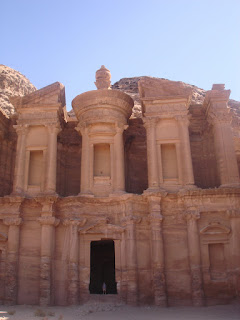A couple of weeks ago, my Egyptology class took another field trip, but instead of just going to a museum, we went to two different pyramid sites. The first site we visited was Meidum.

The Step Pyramid at Meidum
The drive down to Meidum took about 90 minutes. Located south of Giza on the west side of the Nile, Meidum hosts one major pyramid and an array of mastabas (tombs made of mudbrick). The Meidum Step Pyramid was originally intended for the last Pharaoh of the Third Dynasty, Huni. However, it was uncompleted until King Snofru, Huni's successor, rose to power and completed for himself around 2600 BC. The history of the pyramid reveals the development of the architecture of pyramids in ancient Egypt. Originally, royals were buried in mastabas- tombs with a mound of earth as a superstructure and rooms in the substructure. Eventually, this "tumulus" became more structured and began to be built with mudbrick so as to appear to be a house for the deceased or something more permanent than a mound of Earth. Mastabas became more complex when levels were built upon level, eventually resembling the step pyramid you see above. Snofru actually filled in the gaps of the Meidum pyramid, and at one point, it appeared to look like the famous pyramids at Giza. Now, however, Meidum's outer casing has fallen away (or taken to be used for other pyramids).
My class went inside the pyramid. We had to enter from above the first level and go down a very tiny corridor until we reached a flattening point. From here, we had to climb up some ladders to arrive at the actual tomb within the pyramid. It was very small, but I thought it was pretty neat to be inside one of the oldest pyramids of ancient Egypt. The tomb smelled really bad because of the guana (bat feces). After climbing back out of the pyramid, we went inside a mastaba adjacent to the pyramid called Mastaba 17. I thought the name sounded like some new indie rock band, or a star or planet that was really discovered by scientists.

Inside Mastaba 17
Similar to the Step Pyramid, we had to descend deep into the Earth. However, unlike the pyramid, we did not have to climb up again to reach the mortuary chamber. Getting around in the mastaba was more difficult as we had to crawl on our hands and knees and fit through small openings in the limestone in order to reach the tomb. The sarcophagus inside the tomb was interesting because the mallet used by grave-robbers thousands of years ago still holds the top of the sarcophagus up, revealing the inside of the tomb. It doesn't contain anything anymore, but I thought it would be funny if someone hid inside it and scared the rest of the class when they came in. Professor Ikram promptly vetoed my idea.
From Meidum, we headed north towards Dahshur, where King Snofru had two more pyramids built in his honor. According to Dr. Ikram, my Egyptology professor (you can read about her on wikipedia), Snofru was one of the most egotistical pharaohs, second to Ramses II.

Professor Ikram (right) and this other Egyptologist at Dahshur

Bent Pyramid at Dahshur
The first pyramid we visited at Dahshur was the Bent Pyramid. Apparently, when it was being built, the architect thought that the angles were too steep, and decided to make up for this mistake by making the upper portion at a lower angle. As you can see above, the pyramid still has much of its outer limestone casing. The corner that looks like a wrecking ball hit it is another example of the ancient Egyptians taking materials from one site to use at another. The site of Dahshur is actually right next to a military complex, which actually included the pyramids a decade ago. As such, the pyramids aren't as oft visited as the ones at Giza. However, the public is not yet able to go inside the Bent Pyramid. Leaving the Bent Pyramid behind, we headed over to the Red Pyramid.

The Red Pyramid
The Red Pyramid is the world's first true pyramid. Reflecting a culmination of developments in pyramid building. The inside is more complex than Meidum with multiple chambers finally leading to a much larger tomb. The picture below was taken inside the tomb. The corballed ceiling resembles what I saw in Meidum.

Inside the Red Pyramid
I had to get up pretty early, so I was pretty happy to get back on the bus and head home after a long day of pyramid exploring. I love my Egyptology class a lot. It's the only class I have with Egyptians, and it covers unique material that I would never be able to learn at Georgetown. I'm lucky to have a great professor like Dr. Ikram, who knows this stuff inside and out, has worked in the field, and written about all of it. It's nice to go to these ancient sites and know you're going to learn a lot and have a fun time doing it. Hope you enjoyed the pictures.
Ma'a salaama,
Blair
























